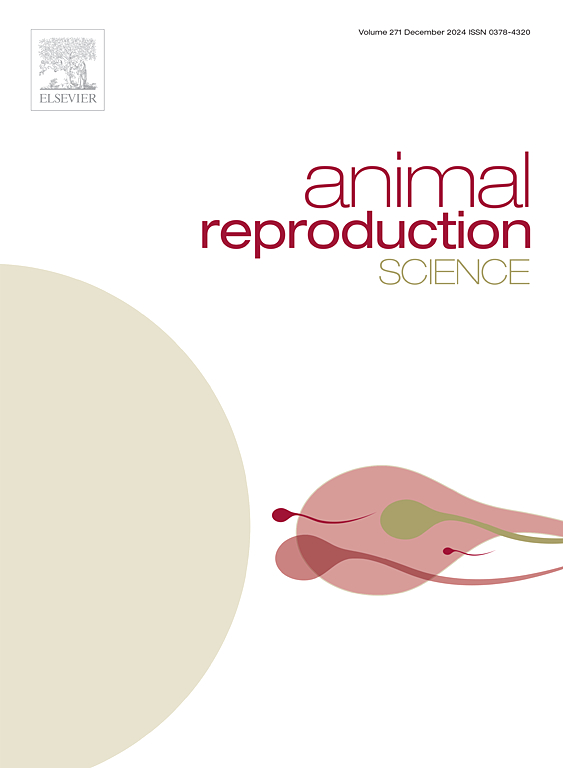Relaxin-like gonad-stimulating peptide promotes gamete maturation and spawning in the sea cucumber Apostichopus japonicus
IF 2.2
2区 农林科学
Q1 AGRICULTURE, DAIRY & ANIMAL SCIENCE
引用次数: 0
Abstract
Apostichopus japonicus is a crucial aquaculture species in Asia, and seedling production is fundamental to its cultivation. Nevertheless, the reproductive behavior of this species remains difficult to regulate artificially. Although the spawning mode of sea cucumbers is well documented, the endocrine mechanisms that regulate the synchronized processes of oocyte maturation and spawning behavior remain poorly understood. In this study, the effects of a recombinant relaxin-like gonad-stimulating peptide (RGP) on oocyte maturation and parental spawning behavior were investigated. The recombinant RGP derived from A. japonicus was effectively expressed using the Pichia pastoris system, and its biological activity was validated through mass spectrometry analysis. Results indicated that the RGP promoted oocyte maturation by inducing the rupture of germinal vesicles. Behavioral studies revealed that the RGP enhanced gamete release. Furthermore, the gametes induced by the RGP did not differ significantly from those released spontaneously in terms of progeny quality and quantity. These findings suggested that the recombinant RGP could be utilized in the breeding of A. japonicus seedlings. They also had substantial implications for elucidating the reproductive behavior of this species and for the artificial induction of seedling production.
松弛素样性腺刺激肽促进刺参配子成熟和产卵
Apostichopus japonicus是亚洲重要的水产养殖品种,种苗生产是其养殖的基础。然而,该物种的繁殖行为仍然难以人为调节。虽然海参的产卵方式已被充分记录,但调节卵母细胞成熟和产卵行为同步过程的内分泌机制仍知之甚少。本研究研究了重组松弛素样性腺刺激肽(RGP)对卵母细胞成熟和亲代产卵行为的影响。利用毕赤酵母系统有效地表达了japonicus重组RGP,并通过质谱分析验证了其生物活性。结果表明,RGP通过诱导胚泡破裂促进卵母细胞成熟。行为学研究表明RGP促进了配子的释放。此外,RGP诱导的配子在子代质量和数量上与自发释放的配子没有显著差异。这些结果表明,重组RGP可用于粳稻幼苗的育种。它们对阐明该物种的繁殖行为和人工诱导幼苗生产也有重要意义。
本文章由计算机程序翻译,如有差异,请以英文原文为准。
求助全文
约1分钟内获得全文
求助全文
来源期刊

Animal Reproduction Science
农林科学-奶制品与动物科学
CiteScore
4.50
自引率
9.10%
发文量
136
审稿时长
54 days
期刊介绍:
Animal Reproduction Science publishes results from studies relating to reproduction and fertility in animals. This includes both fundamental research and applied studies, including management practices that increase our understanding of the biology and manipulation of reproduction. Manuscripts should go into depth in the mechanisms involved in the research reported, rather than a give a mere description of findings. The focus is on animals that are useful to humans including food- and fibre-producing; companion/recreational; captive; and endangered species including zoo animals, but excluding laboratory animals unless the results of the study provide new information that impacts the basic understanding of the biology or manipulation of reproduction.
The journal''s scope includes the study of reproductive physiology and endocrinology, reproductive cycles, natural and artificial control of reproduction, preservation and use of gametes and embryos, pregnancy and parturition, infertility and sterility, diagnostic and therapeutic techniques.
The Editorial Board of Animal Reproduction Science has decided not to publish papers in which there is an exclusive examination of the in vitro development of oocytes and embryos; however, there will be consideration of papers that include in vitro studies where the source of the oocytes and/or development of the embryos beyond the blastocyst stage is part of the experimental design.
 求助内容:
求助内容: 应助结果提醒方式:
应助结果提醒方式:


